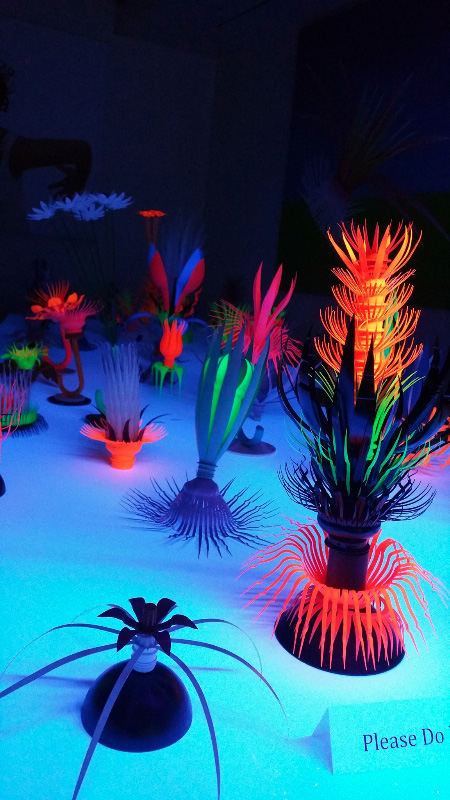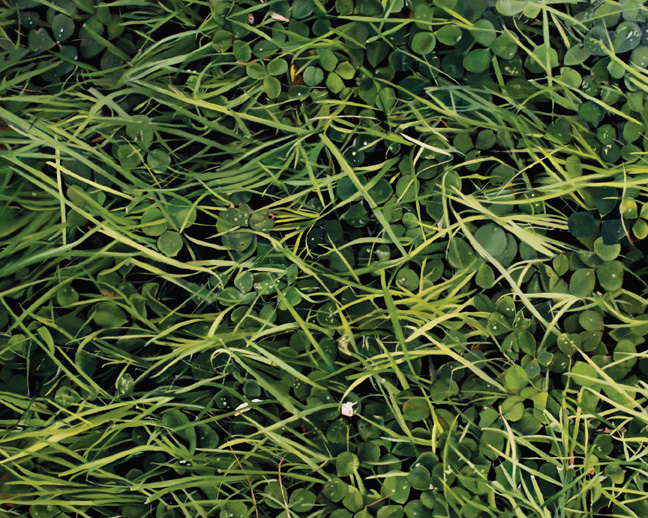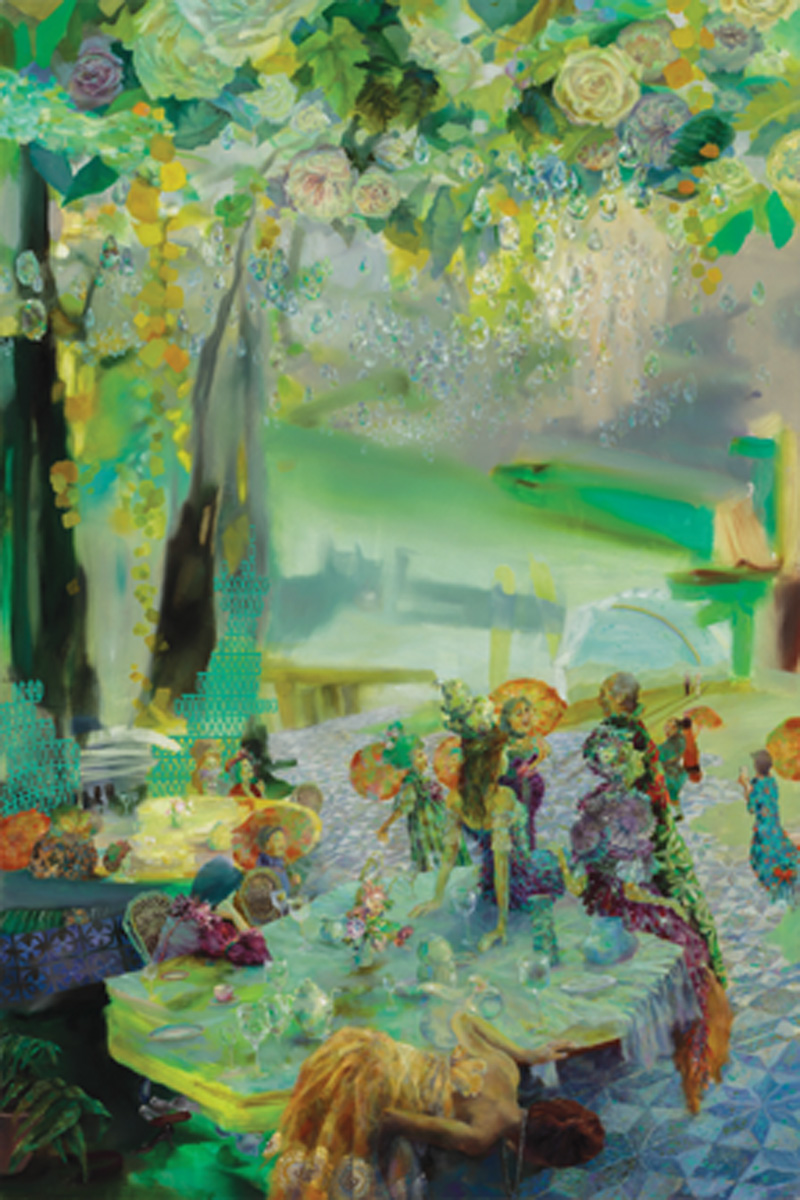« Reviews
Natural Proclivities
Shirley Fiterman Art Center - New York
Curated by Kim Power and Melanie Vote
By Peter Drake
“Natural Proclivities” represents creative responses to nature, “from growth to decay.” That’s a tall order, but this show delivers, and then some. Most artists who address nature in their work fall on one side of this spectrum or the other; either with a blind embrace of natural beauty or visions of a natural apocalyptic dystopia that represents mankind and nature at each other’s throats. The most compelling artists in this show find ways to keep the viewer guessing by using their craft and visual intelligence to lure the viewer into a more complex and uncertain relationship with nature.
Emma Tapley’s Cultivating the Empty Field presents us with an all-over composition of a Pollock-like field of twisting reeds and leaves. It’s beautifully painted and seemingly innocuous, but the densely knotted foliage is fraught with a sense of entrapment. Viewers are given both sensuously painted nature and what it might look like if nature fought back. If you have ever seen what happens to an unattended road in the tropics, this image will be familiar to you and frightening.
In Frozen Lagoon, Lisa Lebofsky presents a similarly reductive representation of nature, but in her case shards of frozen water crisscross the picture plane like slabs of Ab-Ex paint. The awesome power of nature is unquestionable in her painting, but one is also struck by the calligraphic beauty of these giant mounds of ice. This is a landscape where nothing appears to live and yet it remains eerily peaceful.

Eteri and Gorcha Chkadua, Alien Blooms, mixed media, spray paint, plastic disposable bottles, umbrella holders, corks, 175” x 50” 20”, 2016-2018. Courtesy of Eteri and Gorcha Chkadua
A number of the artists in the show use narrative in a way that splits the difference in the growth/decay equation. In Sibyl’s Foley, Vera Iliatova riffs on illustration motifs that come straight out of The Saturday Evening Post. A brightly colored bouquet of flowers acts as a barrier that the viewer must sidestep to arrive at the discreet, micro-narrative in the upper left-hand corner of the painting. The three women depicted appear to be in conflict. A kneeling figure has grabbed the collar of a seated figure while a third dispassionately looks on. In this case, nature is a lovely but deceptive screen, allowing the viewer to be aware of potential violence but keeping them at arm’s length. There is the sense in Iliatova’s work that nature acts as a prophylactic against the close inspection of pain, humiliation and human weakness.
Zachari Logan uses a similar device in Eunuch Tapestry 4, but in this case the protagonist (a bearded male figure) appears to be hiding from the viewer. The thick veil of swirling plants protects the subject from scrutiny that might be too invasive. The precisionist depictions of the plants suggest the decorative elements of The Cloisters’ Unicorn Tapestries, in which the final scene finds the unicorn corralled and apparently tamed. Here we find the titular eunuch to be similarly surrounded by nature, presumably for his own good.
In addition to depicting nature, some of the artists in “Natural Proclivities” use paint to act as a stand-in for nature. In Elisabeth Condon’s Tsunami Plants, the artist uses stain painting and impasto to create a visual parallel to an unstoppable flood of water. This is what happens when paint is allowed to be just that, paint; it is thick, unwieldy and beautifully itself. The plant life that gets caught up in this torrent of material is swept away, becoming a textile afterthought.
Ali Miller uses similar contrasts in painting vernacular to become a representation of the painting paradigm. There is direct and indirect painting, stain painting, loaded-brush, precisionist and gestural paintings, all the tools of the trade being used to depict an haut-bourgeoisie tea party that has hints of Florine Stettheimer and Odilon Redon. What is most interesting in this piece are the floral motifs that adhere to the characters. They have become, or are becoming, plant/human hybrids in a mesmerizing jeweled landscape.
In Fast Fashion, Daniel Bilodeau creates an uncanny narrative out of an eerily suspended still life. All the elements of this painting appear to be frozen in time, like the famous portrait of Dalí and his flying cats. There is a bagged goldfish pouring water into a rocks-glass vase filled with flowers, golden characters and miniature flame stamps. Something about this painting feels like a Rube Goldberg contraption in which everything is necessary to complete an absurd task, but what that task is remains just out of reach.
The sculptures in “Natural Proclivities” represent a range of concerns, including transformation, empathy and hybridization. Naomi Campbell and Eteri and Gocha Chkadua come down on the dark side of nature’s future. Campbell’s From Here is Everywhere I, represents the brittle promise of engineered plant life. This is a J.G. Ballard world in which nature has been fortified into unrecognizability; flower petals are glass shards, and their stems are made of rebar, keeping the viewer at a safe but disconnected distance.
The Chkaduas create vibrant floral mutations out of discarded plastics and the detritus of our disposable world. This should feel positive, since waste is being transformed into beauty, but these Day-Glo plastic flowers are closer to sea creatures that have transmogrified after years of contact with human castoffs; they are beautiful but remain alien and unfamiliar.
A Victorian tea service seems to have gone mad in Joan Bankemper’s Morning Glory. Tripped-out floral motifs are presented in such abundance that it’s as if Mother Nature has had it up to here with dainty depictions of the natural world. The Gaudi-like encrustations seem to be both critiquing the origins of this imagery and saying something about underestimating the dangers of nature’s fecundity.
By sharp contrast, Elizabeth Demaray creates woolen comforters for plants. In Plant Sweaters, she has made a form of “inter-species giving” that is tender, homespun and absurd. This is what happens when sincere concern for nature’s future collides with limited means. Anyone can make a plant sweater, just get your knitting needles out and warm up a tree. There is futility and determination here that I found genuinely touching.

Emma Tapley, Cultivating the Empty Field, 2017, oil on clayboard, 24” x 30.” Courtesy of the artist.
“Natural Proclivities” represents hope and fear, dread and willfulness and an abundance of genuine concern for and connection to the natural world. It is a timely show that features an impressive array of artists and a lively series of conversations and cross-pollinations.
(May 24 - July 27, 2018)
Peter Drake is an artist, curator, writer and the provost at the New York Academy of Art.
Filed Under: Reviews




































Leave a Reply
You must be logged in to post a comment.